|
Category
|
Country Palace Sitorai Mohi Khosa
Construction of the palace was begun in the late XIX century, when by order of the Emir Abdulahad Khan, the best Bukhara masters were sent to Russia (St. Petersburg and Yalta) to study the experience of Russian architects out there. Therefore, the ensemble is a mix of European architecture with the architecture of the palaces of Iran's Isfahan and wealthy houses of Bukhara. According to one version, the palace got its name in honor of Abdulahad Khan’s Mother, beloved wife of the Emir Muzaffar Khan, whose name was Shamshat. Initially, a group of local architects, headed by Hafiz Hodja usto erected rich structure, which combines local Bukharian and European traditions. Major role in the palace throne room of the building has played under the arches of which was located during the reception court elite.
In the garden - isolated areas of the khan of the harem. The main building of the palace, contains several reception rooms and private quarters of the Emir. Among them the famous White Hall, built in two years (1912-1914) by group of artists led by the famous masters – usto Shirin Muradov. And now White Hall shines blindingly bright white clean “gulganch” covering walls and ceilings. For decoration and equipment of the palace were imported from Russia, mirrors, tile Dutch oven, crystal chandeliers, moldings and furniture.
In the construction of the palace was attended by the famous masters of his time - Hasanzhon Umarov, Abdullah Gafurov, Hayot Raheem, Ibrahim Khafizov, Karim Samadov, usto Jura, usto Khodjakuli, usto Shirin Muradov, as well as two Russian engineers - Margulis and Sakovich in the service at the court of the Emir . Palace Sitorai-Mohi Khosa - the only surviving country palace, who survived the October revolution and the overthrow of the Bukhara Emirate.
At present, the palace complex houses the Museum of Decorative and Applied Art, which displays the following exhibitions: "The interior of the summer palace" (main building). Here are exhibited the palace furniture XIX-XX centuries, Chinese and Japanese porcelain XIV-XX centuries, the palace of the Russian art, jewelry famous Bukhara masters, gold panels and blankets.
A collection of gold-court apparel, belts, scarves, shoes. "Artistic embroidery of Bukhara region, and household utensils late XIX-early XX centuries." The composition of the collection: decorative panel "Suzanne," prayer rugs "dzhoynamozy" covers for pillows "takiyapush" embroidered curtains "chimilik." Ethnographic exhibition interior of the house of urban residents of Bukhara. In the palace garden were carried out research and restoration work, rebuilt the fortress wall, pavilions, ancient flora and fauna. At the Palace Sitorai Mohi Khosa also operates Spa Resort. The Health Center is treatment of diseases of the kidneys, musculoskeletal system, nervous system, digestive system and andrological diseases. |
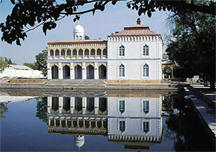 Country Palace Sitorai Mohi Khosa ("The stars, like the moon") is loc ated 4 kilometers north of Bukhara. The palace is divided into old and new.
Country Palace Sitorai Mohi Khosa ("The stars, like the moon") is loc ated 4 kilometers north of Bukhara. The palace is divided into old and new.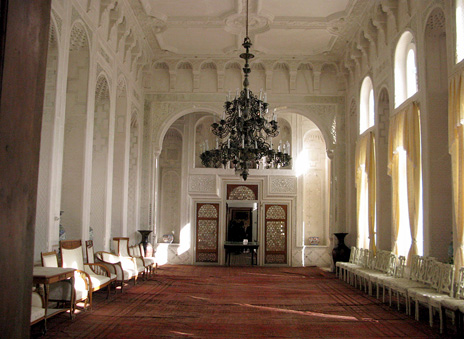 Great artistic value is a new palace, which was built during the reign of the last Emir of Bukhara Said Alim-khan. New palace was built next to the old and includes several buildings. Here and in the triumphal arch entrance gate with a mosaic decoration, and the gallery encircling the courtyard with a straight stand, and the case of European architecture from the greenhouse before the big pool. In general, the palace, built in European style, but is divided into male and female, and inside is decorated in Oriental style.
Great artistic value is a new palace, which was built during the reign of the last Emir of Bukhara Said Alim-khan. New palace was built next to the old and includes several buildings. Here and in the triumphal arch entrance gate with a mosaic decoration, and the gallery encircling the courtyard with a straight stand, and the case of European architecture from the greenhouse before the big pool. In general, the palace, built in European style, but is divided into male and female, and inside is decorated in Oriental style.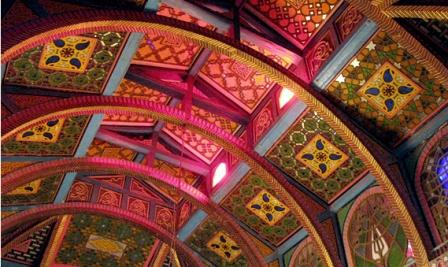 The main entrance to the palace is decorated with statues of marble lions, carved by craftsmen from Bukhara Gazgan marble.
The main entrance to the palace is decorated with statues of marble lions, carved by craftsmen from Bukhara Gazgan marble.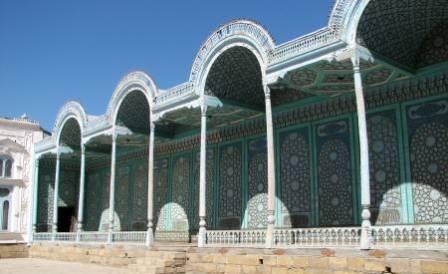 In 1927 the palace was a museum. Active participation in the creation of a museum took the first Uzbek museum curator Musadjan Saidjanov that in the years of Stalin's repressions in 1937 was arrested as an "enemy of the people" and executed.
In 1927 the palace was a museum. Active participation in the creation of a museum took the first Uzbek museum curator Musadjan Saidjanov that in the years of Stalin's repressions in 1937 was arrested as an "enemy of the people" and executed.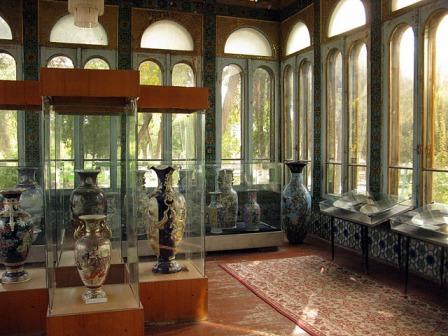 "Clothes of Bukhara city dweller late XIX-early XX cen turies" (octagonal pavilion).
"Clothes of Bukhara city dweller late XIX-early XX cen turies" (octagonal pavilion).














